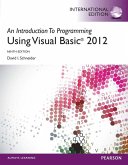Robert C. Martin
Agile Software Development, Principles, Patterns, and Practices (eBook, PDF)
Pearson New International Edition
42,95 €
42,95 €
inkl. MwSt.
Sofort per Download lieferbar

21 °P sammeln
42,95 €
Als Download kaufen

42,95 €
inkl. MwSt.
Sofort per Download lieferbar

21 °P sammeln
Jetzt verschenken
Alle Infos zum eBook verschenken
42,95 €
inkl. MwSt.
Sofort per Download lieferbar
Alle Infos zum eBook verschenken

21 °P sammeln
Robert C. Martin
Agile Software Development, Principles, Patterns, and Practices (eBook, PDF)
Pearson New International Edition
- Format: PDF
- Merkliste
- Auf die Merkliste
- Bewerten Bewerten
- Teilen
- Produkt teilen
- Produkterinnerung
- Produkterinnerung

Bitte loggen Sie sich zunächst in Ihr Kundenkonto ein oder registrieren Sie sich bei
bücher.de, um das eBook-Abo tolino select nutzen zu können.
Hier können Sie sich einloggen
Hier können Sie sich einloggen
Sie sind bereits eingeloggt. Klicken Sie auf 2. tolino select Abo, um fortzufahren.

Bitte loggen Sie sich zunächst in Ihr Kundenkonto ein oder registrieren Sie sich bei bücher.de, um das eBook-Abo tolino select nutzen zu können.
Agile Software Development, Principles, Patterns, and Practices
- Geräte: PC
- ohne Kopierschutz
- eBook Hilfe
Andere Kunden interessierten sich auch für
![Object-Oriented Software Engineering Using UML, Patterns, and Java (eBook, PDF) Object-Oriented Software Engineering Using UML, Patterns, and Java (eBook, PDF)]() Bernd BrueggeObject-Oriented Software Engineering Using UML, Patterns, and Java (eBook, PDF)42,95 €
Bernd BrueggeObject-Oriented Software Engineering Using UML, Patterns, and Java (eBook, PDF)42,95 €![Patterns, Principles, and Practices of Domain-Driven Design (eBook, PDF) Patterns, Principles, and Practices of Domain-Driven Design (eBook, PDF)]() Scott MillettPatterns, Principles, and Practices of Domain-Driven Design (eBook, PDF)39,99 €
Scott MillettPatterns, Principles, and Practices of Domain-Driven Design (eBook, PDF)39,99 €![Writing Effective Use Cases (eBook, PDF) Writing Effective Use Cases (eBook, PDF)]() Alistair CockburnWriting Effective Use Cases (eBook, PDF)31,95 €
Alistair CockburnWriting Effective Use Cases (eBook, PDF)31,95 €![Compilers: Principles, Techniques, and Tools (eBook, PDF) Compilers: Principles, Techniques, and Tools (eBook, PDF)]() Alfred V. AhoCompilers: Principles, Techniques, and Tools (eBook, PDF)42,95 €
Alfred V. AhoCompilers: Principles, Techniques, and Tools (eBook, PDF)42,95 €![Software Engineering, Global Edition (eBook, PDF) Software Engineering, Global Edition (eBook, PDF)]() Ian SommervilleSoftware Engineering, Global Edition (eBook, PDF)42,95 €
Ian SommervilleSoftware Engineering, Global Edition (eBook, PDF)42,95 €![Fundamentals of Web Development, Global Edition (eBook, PDF) Fundamentals of Web Development, Global Edition (eBook, PDF)]() Randy ConnollyFundamentals of Web Development, Global Edition (eBook, PDF)42,95 €
Randy ConnollyFundamentals of Web Development, Global Edition (eBook, PDF)42,95 €![Introduction to Programming with Visual Basic 2012, An (eBook, PDF) Introduction to Programming with Visual Basic 2012, An (eBook, PDF)]() Stuart RegesIntroduction to Programming with Visual Basic 2012, An (eBook, PDF)42,95 €
Stuart RegesIntroduction to Programming with Visual Basic 2012, An (eBook, PDF)42,95 €-
-
-
Agile Software Development, Principles, Patterns, and Practices
Dieser Download kann aus rechtlichen Gründen nur mit Rechnungsadresse in A, B, BG, CY, CZ, D, DK, EW, E, FIN, F, GR, HR, H, IRL, I, LT, L, LR, M, NL, PL, P, R, S, SLO, SK ausgeliefert werden.
Produktdetails
- Produktdetails
- Verlag: Pearson HigherEducation
- Seitenzahl: 536
- Altersempfehlung: ab 18 Jahre
- Erscheinungstermin: 29. August 2013
- Englisch
- ISBN-13: 9781292038360
- Artikelnr.: 41940295
- Verlag: Pearson HigherEducation
- Seitenzahl: 536
- Altersempfehlung: ab 18 Jahre
- Erscheinungstermin: 29. August 2013
- Englisch
- ISBN-13: 9781292038360
- Artikelnr.: 41940295
- Herstellerkennzeichnung Die Herstellerinformationen sind derzeit nicht verfügbar.
I. AGILE DEVELOPMENT.
1. Agile Practices.
2. Overview of Extreme Programming.
3. Planning.
4. Testing.
5. Refactoring.
6. A Programming Episode.
II. AGILE DESIGN.
7. What Is Agile Design?
8. SRP: The Single-Responsibility Principle.
9. OCP: The Open-Closed Principle.
10. LSP: The Liskov Substitution Principle.
11. DIP: The Dependency-Inversion Principle.
12. ISP: The Interface-Segregation Principle.
III. THE PAYROLL CASE STUDY.
13. Command and Active Object.
14. Template Method & Strategy: Inheritance vs. Delegation.
15. Facade and Mediator.
16. Singleton and Monostate.
17. Null Object.
18. The Payroll Case Study: Iteration One Begins.
19. The Payroll Case Study: Implementation.
IV. PACKAGING THE PAYROLL SYSTEM.
20. Principles of Package Design.
21. Factory.
22. The Payroll Case Study (Part 2).
V. THE WEATHER STATION CASE STUDY.
23. Composite.
24. Observer—Backing into a Pattern.
25. Abstract Server, Adapter, and Bridge.
26. Proxy and Stairway to Heaven: Managing Third Party APIs.
27. Case Study: Weather Station.
VI. THE ETS CASE STUDY.
28. Visitor.
29. State.
30. The ETS Framework.
Appendix A. UML Notation I: The CGI Example.
Appendix B. UML Notation II: The Statmux.
Appendix C. A Satire of Two Companies.
Index.
1. Agile Practices.
2. Overview of Extreme Programming.
3. Planning.
4. Testing.
5. Refactoring.
6. A Programming Episode.
II. AGILE DESIGN.
7. What Is Agile Design?
8. SRP: The Single-Responsibility Principle.
9. OCP: The Open-Closed Principle.
10. LSP: The Liskov Substitution Principle.
11. DIP: The Dependency-Inversion Principle.
12. ISP: The Interface-Segregation Principle.
III. THE PAYROLL CASE STUDY.
13. Command and Active Object.
14. Template Method & Strategy: Inheritance vs. Delegation.
15. Facade and Mediator.
16. Singleton and Monostate.
17. Null Object.
18. The Payroll Case Study: Iteration One Begins.
19. The Payroll Case Study: Implementation.
IV. PACKAGING THE PAYROLL SYSTEM.
20. Principles of Package Design.
21. Factory.
22. The Payroll Case Study (Part 2).
V. THE WEATHER STATION CASE STUDY.
23. Composite.
24. Observer—Backing into a Pattern.
25. Abstract Server, Adapter, and Bridge.
26. Proxy and Stairway to Heaven: Managing Third Party APIs.
27. Case Study: Weather Station.
VI. THE ETS CASE STUDY.
28. Visitor.
29. State.
30. The ETS Framework.
Appendix A. UML Notation I: The CGI Example.
Appendix B. UML Notation II: The Statmux.
Appendix C. A Satire of Two Companies.
Index.
I. AGILE DEVELOPMENT.
1. Agile Practices.
2. Overview of Extreme Programming.
3. Planning.
4. Testing.
5. Refactoring.
6. A Programming Episode.
II. AGILE DESIGN.
7. What Is Agile Design?
8. SRP: The Single-Responsibility Principle.
9. OCP: The Open-Closed Principle.
10. LSP: The Liskov Substitution Principle.
11. DIP: The Dependency-Inversion Principle.
12. ISP: The Interface-Segregation Principle.
III. THE PAYROLL CASE STUDY.
13. Command and Active Object.
14. Template Method & Strategy: Inheritance vs. Delegation.
15. Facade and Mediator.
16. Singleton and Monostate.
17. Null Object.
18. The Payroll Case Study: Iteration One Begins.
19. The Payroll Case Study: Implementation.
IV. PACKAGING THE PAYROLL SYSTEM.
20. Principles of Package Design.
21. Factory.
22. The Payroll Case Study (Part 2).
V. THE WEATHER STATION CASE STUDY.
23. Composite.
24. Observer—Backing into a Pattern.
25. Abstract Server, Adapter, and Bridge.
26. Proxy and Stairway to Heaven: Managing Third Party APIs.
27. Case Study: Weather Station.
VI. THE ETS CASE STUDY.
28. Visitor.
29. State.
30. The ETS Framework.
Appendix A. UML Notation I: The CGI Example.
Appendix B. UML Notation II: The Statmux.
Appendix C. A Satire of Two Companies.
Index.
1. Agile Practices.
2. Overview of Extreme Programming.
3. Planning.
4. Testing.
5. Refactoring.
6. A Programming Episode.
II. AGILE DESIGN.
7. What Is Agile Design?
8. SRP: The Single-Responsibility Principle.
9. OCP: The Open-Closed Principle.
10. LSP: The Liskov Substitution Principle.
11. DIP: The Dependency-Inversion Principle.
12. ISP: The Interface-Segregation Principle.
III. THE PAYROLL CASE STUDY.
13. Command and Active Object.
14. Template Method & Strategy: Inheritance vs. Delegation.
15. Facade and Mediator.
16. Singleton and Monostate.
17. Null Object.
18. The Payroll Case Study: Iteration One Begins.
19. The Payroll Case Study: Implementation.
IV. PACKAGING THE PAYROLL SYSTEM.
20. Principles of Package Design.
21. Factory.
22. The Payroll Case Study (Part 2).
V. THE WEATHER STATION CASE STUDY.
23. Composite.
24. Observer—Backing into a Pattern.
25. Abstract Server, Adapter, and Bridge.
26. Proxy and Stairway to Heaven: Managing Third Party APIs.
27. Case Study: Weather Station.
VI. THE ETS CASE STUDY.
28. Visitor.
29. State.
30. The ETS Framework.
Appendix A. UML Notation I: The CGI Example.
Appendix B. UML Notation II: The Statmux.
Appendix C. A Satire of Two Companies.
Index.







